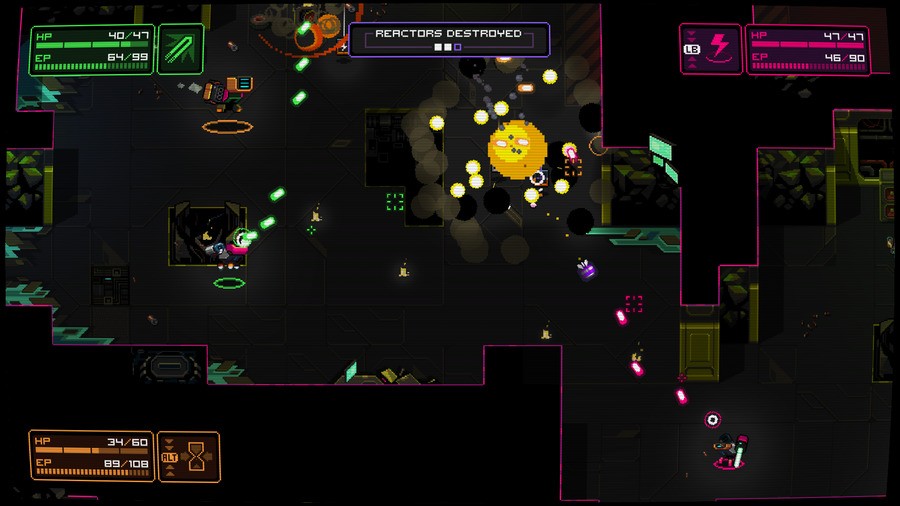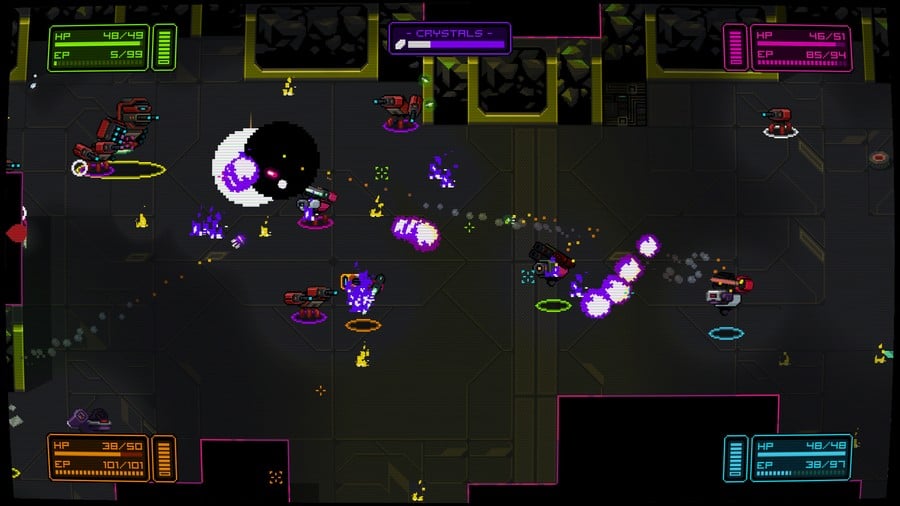
NeuroVoider is a twin-stick shooter RPG set in a futuristic world, and has a pretty striking preoccupation with robots and rocket launchers. It launched last week on the Switch eShop, so we though it would be the ideal time to speak to Flying Oak Games' Thomas Altenburger about the game.
Nintendo Life: What is the story behind the title 'Neuro Voider'?
Thomas Altenburger: It's basically the most cheesy pitch you can find! Imagine it with being said in a low voice: "In a world where humanity has been annihilated by the robot uprising, the last human brains in captivity break out to this endless party."
 Watch on YouTube
Watch on YouTubeSubscribe to Nintendo Life on YouTube841k
What attracted you to develop for switch?
NeuroVoider is a game that we thought as "couch game" from the start, with the possibility to share the experience with three other friends. The concept of the Switch itself is what fits the best this vision, hence the fact that we couldn't miss the opportunity to release it there. We believe it's a perfect match!
Considering the nature of the hardware, has the co-op multiplayer changed at all? How was the transition from TV to portable in terms of development?
Nothing changed at all; the Switch is one great platform to work with. The cool thing is that we managed to create a single-JoyCon control scheme, even though it's a twin-stick game. You can enjoy multiplayer with any kind of controller configuration, which is something really neat we wanted to have on Switch in order to allow smooth and seamless multiplayer experience.
What was your exposure and interest to the rumours of the 'NX'?
We had quite a few game dev friends who had a NX before its announcement, but we couldn't get any information from them. The NX was shrouded in mystery even to us; everything was still rumours. We watched the console reveal live, and we were quite thrilled about it.
NeuroVoider's soundtrack is a particular highlight. How did the collaboration come about and what was the starting point in terms of objective?
When we started working on NeuroVoider, we listened to a lot of synthwave music while working in order to get the tone that we wanted the game to have. Dan Terminus was among those artists that we listened to, and he quickly became an office favorite. Without even noticing it, we built a game that had his music in mind. We felt we were stuck in a dead end and asked him and his label for a collaboration, without any relevant backup if they declined. It turned he and his label are super-lovely, and we managed to build a great collaboration.
How do the procedurally-generated aspects of the game come together? Have you come across any favourite robots / levels / load outs?
We have our personal preferred load outs, but revealing them would break the charm of the discovery. The game behaves a bit like The Binding of Isaac, each run is different and may yield different loot; you can't always build your favourite load out, so you have to adapt. You can however choose a class and skill that will stay for all the run.

There's a lot going on in NeuroVoider - bosses, looting, customization. Was there any aspect that was the focus, or did everything come together organically?
We built the game step-by-step with the community by releasing weekly updates, 56 of them since the first alpha. Each of them packs new stuff, revamped stuff or removed stuff. We had the main idea - the twin-stick RPG shooting was there from the start - but a lot of the game feel has evolved through this process. The game is very different, and better than what it was when the project started. Kudos to our players for that!
What are your personal favourite Nintendo games that have influenced NeuroVoider?
Even though it's not quite a shooter, the Metroid series is a personal favourite when it comes to setting the mood of a game, and I believe that if we could, we would totally think about making a "Metroidvania" as a future project. Other non-Nintendo influences were Diablo or Borderlands, for the RPG aspects.
The game is not only a homage to dystopian science fiction, but there's also a distinct pixel art style and vibrant colour palette (as well as some humour). What were the early markers for the tone and aesthetic?
Our main reference here is Dungeon of the Endless, which boasts an excellent art direction mixing super colourful stuff, yet having a dark atmosphere. It's typically what we think defines science fiction or cyber punk, and what we wanted to match as a global mood. Kudos to their team for achieving this.





Comments 15
Really happy to hear that the Switch is easy to work with.
I like me a good twin stick shooter!
Picked the game and immediately picked up the soundtrack. Both are highly recommended by yours truly.
This game isn't fun at all. You guns over heat so you can't rapid fire and it ruins the experience. Also it's boring to look at.
Really nice game so far. I have yet to make it to the final boss though. I'm really liking the game, but I'm very curious to try out the multiplayer using two Joy-Con. Part of me is sceptical but the other part of me thinks it'll be a blast. But... twin stick...
@Biff_ARMStrong The bigger, much more destructive guns overheat the quickest. The weaker guns tend to allow you the spam you're looking for.
It's a shame this isn't the kind of game you're into, but your experience with it can't be that bad, right?
@ThatNyteDaez Yeah but the weaker guns don't do enough damage. This mechanic should have been scrapped. Why play this when I can play a good twin stick shooter like Smash TV and Binding of Isaac? I can rapid fire all I want
Great! Happy to see how this turned out!
I am enjoying this game a lot. I was able to grasp the concept of it being hard. I thought it was going to be another rogue game with too many things thrown at you. Like that balancing game. Soundtrack is awesome. Found it and bought. Honestly its only thing being played right now. There is just enough variation to keep me coming back. I already beat Mario rabbids...yeah.
Grabbing this next pay day! Looks superb
picked this up as a fan of twin stick shooters and rogue-likes. excellent balance, loot, weapons, swarms and mini-bosses. the music is outstanding. have made 3 good runs through the game getting 'round half way with the fortress type. i personally love the combination of a heavy area of effect left hand weapon and rail gun right hand weapon. immensely replayable
have made dozens of attempts that ended badly. requires concentration it must be the absolute business in local multiplayer. easily recommended. its like shiren the wanderer meets top down doom with a ridiculous level of customisation
Can't wait for the review!
This game is great stuff...a strangely addicting lure to it in a way though I haven't made it close to a 100% completion yet. I like the music, too.
This one swarm level straight up kicked my ass though... xD It seemed like I couldn't quite get near the reactor due to champions consistently chasing me away in droves.
I was really excited for this game, but it's brain-numbingly boring. Easily one of the least fun twin-stick shooters I've ever played. The soundtrack is fine, but gawd, it's just so so so bland. I really regret buying it. Probably a 3/10.
Show Comments
Leave A Comment
Hold on there, you need to login to post a comment...